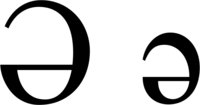Ə
This article needs additional citations for verification. (September 2014) |
| Schwa | |
|---|---|
| Ə ə | |
 | |
| Usage | |
| Writing system | Latin script |
| Type | Alphabetic |
| Language of origin | Azerbaijani language |
| Sound values | [æ] [ə] |
| In Unicode | U+018F, U+0259 |
| History | |
| Development | |
| Time period | ~1922 to 1939, 1992 to present |
| Descendants | • Ә |
| Other | |
| Writing direction | Left-to-Right |
Ə ə, also called schwa, is an additional letter of the Latin alphabet, used in the Azerbaijani language, in Gottscheerish, and in the hən̓q̓əmin̓əm̓ dialect of Halkomelem. Both the majuscule and minuscule forms of this letter are based on the form of an upside down e, while the Pan-Nigerian alphabet pairs the same lowercase letter with Ǝ.
In the International Phonetic Alphabet (IPA), minuscule ə is used to represent the mid central vowel or a schwa. A superscript minuscule ᵊ is used to modify the preceding consonant to have a mid central vowel release, though it is also commonly used to indicate possible syllabicity of the following sonorant, especially in transcriptions of English. The latter usage is non-standard.
The letter was used in the Uniform Turkic Alphabet, for example in Janalif for the Tatar language in the 1920s–1930s. In the Latin Azerbaijani and Chechen alphabets, Ə represents the near-open front unrounded vowel, /æ/. Also, in a romanization of Pashto, the letter Ə is used to represent [ə]. When some Roman orthographies in the Soviet Union were converted to use the Cyrillic script in the 1930s and 1940s, this letter has been adopted verbatim.
In the Latin transliteration of Avestan, the corresponding long vowel is written as schwa-macron, Ə̄/ə̄.
An r-colored vowel can be represented using ɚ.
A schwa with a retroflex hook (ᶕ) is used in phonetic transcription.[1]
Unicode encodings
| Preview | Ə | ə | ᵊ | ₔ | ||||
|---|---|---|---|---|---|---|---|---|
| Unicode name | LATIN CAPITAL LETTER SCHWA | LATIN SMALL LETTER SCHWA | MODIFIER LETTER SMALL SCHWA | LATIN SUBSCRIPT SMALL LETTER SCHWA | ||||
| Encodings | decimal | hex | dec | hex | dec | hex | dec | hex |
| Unicode | 399 | U+018F | 601 | U+0259 | 7498 | U+1D4A | 8340 | U+2094 |
| UTF-8 | 198 143 | C6 8F | 201 153 | C9 99 | 225 181 138 | E1 B5 8A | 226 130 148 | E2 82 94 |
| Numeric character reference | Ə |
Ə |
ə |
ə |
ᵊ |
ᵊ |
ₔ |
ₔ |
Since the legacy fixed 8-bit ISO/IEC Turkish encoding does neither contain Ə nor ə, Ä ä has sometimes been used for the Azerbaijani language instead, as in the Tatar and Turkmen languages.
In Windows, the characters can be generated by holding the ⎇ Alt key and pressing the respective decimal Unicode number, which can be found in the table (e.g. 399, 601), on the number pad preceded by a leading 0. With the GNOME desktop environment, the lowercase letter is by default generated by Compose+e+e. In OS X with the U.S. Extended keyboard, the letters Ə ə are made with ⌥ Option+⇧ Shift+: followed by ⇧ Shift+A or a respectively.
References
- ^ Constable, Peter (2004-04-19). "L2/04-132 Proposal to add additional phonetic characters to the UCS" (PDF).
